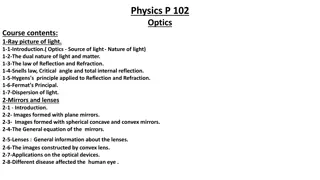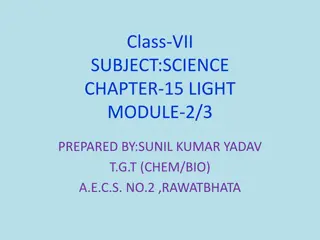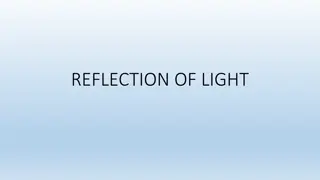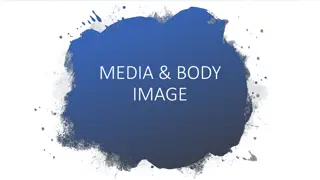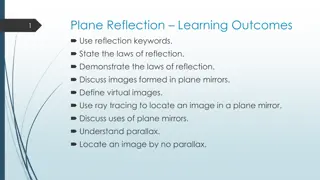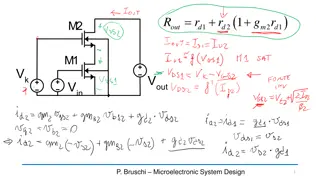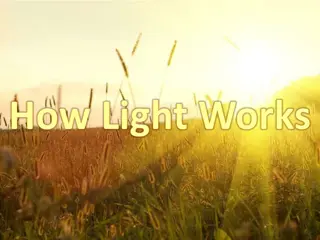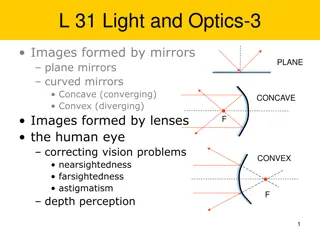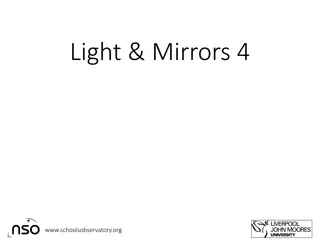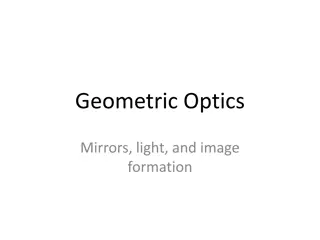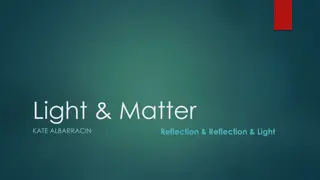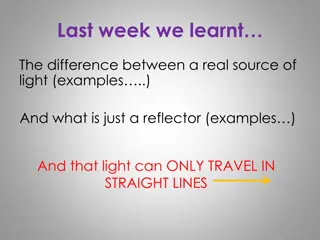Understanding Light: Image Formation, Mirrors, and Properties
Light is a form of electromagnetic energy essential for vision. Explore its properties, including reflection, refraction, virtual and real images formed by mirrors, laws of reflection, and characteristics of images. Delve into concave and convex mirrors, understanding focal points and image formation.
Download Presentation

Please find below an Image/Link to download the presentation.
The content on the website is provided AS IS for your information and personal use only. It may not be sold, licensed, or shared on other websites without obtaining consent from the author. Download presentation by click this link. If you encounter any issues during the download, it is possible that the publisher has removed the file from their server.
E N D
Presentation Transcript
Light Image formation, Mirrors, Properties
Light It is a form of Electromagnetic Energy. Part of Electromagnetic spectrum and is the only part where we can see.
The speed of light C is constant in the vacuum. Speed of light c=3.0*108m/s. Light can be : Reflected, Refracted and Absorbed. Light is an electromagnetic wave in that it has wave like properties which can be influenced by electric and magnetic fields.
Law of Reflection It states that angle of incidence (incoming ray) is equal to angle of reflection (outgoing ray) The law works for Flat, Plane surfaces only. The angles are measured from perpendicular line to the surface called NORMAL.
Virtual Image These cannot be projected on screen. Virtual images are always on the OPPOSITE side of the mirror relative to the Object.
Real Image Real images are the one which can be projected on to the screen. For MIRRORS, they always appear on the same side of the mirror as the object. The characteristics of the image however may be different from the original object.
These characteristics are: Size (reduced, enlarged, same size) Position ( same side or opposite side) Orientation ( right side up, inverted) What if the mirror isn t flat?
Converging (Concave) Mirror A converging mirror is one that is spherical in nature by which it can focus all Parallel light rays to a point directly in front of its surface. Every spherical mirror can do this and is at a fixed point for each mirror. This point is called as Focal point. To find this point, one must use light from Infinity.
Since the mirror is spherical, technically has a Center of Curvature (C). The focal point happens to be HALF this distance. f= C/2 C= 2f A line is drawn through centre of the mirror called Principle axis.
Ray Diagram A ray diagram is a pictorial representation of how light travels to form an image and can tell the characteristics of the image.
Rule 1: Draw a ray, starting from the top of the object parallel to the principle axis and then through f after reflection.
Rule 2: Draw a ray, starting from the top of the object through the focal point then parallel to the principle axis.
Rule 3: Draw a ray, starting from the top of the object through C then back upon itself. What do you notice about three lines? Where do they intersect? The intersection is the location of the image.
Image Characteristics: After getting the intersection, draw an arrow down from the principle axis to the point of intersection.
Notify the following characteristics: 1. Is the image on the same side or opposite side of the mirror as the object? 2. Is the image enlarged or reduced? 3. Is the image inverted or right side up?
The Mirror/Lens Equation Is there any other way to predict the image characteristics besides the ray diagram? One way is to use the Mirror/ Lens equation to calculate the position of the image. 1/f=1/do+ 1/di
For example: The focal length of a concave spherical mirror is 10 cm and the object distance is at 25 cm, Calculate the image distance and its characteristics. 1/f= 1/do+1/di
If the image distance is positive, then it is a Real Image. Real image= Positive image distance Virtual image= Negative image distance To know the orientation and size of the image, use the Magnification Equation. M= -di/do
If we get a positive magnification, the image is upright. If we get a negative magnification, the image is inverted. If the magnification value is greater than 1, the image is enlarged. If the magnification value is less than 1, the image is reduced. If the magnification value is equal to 1 the image size is equal to object size.
Refraction, Absorption and Reflection The color of the objects we see in the natural world is a result of the way objects interact with light. When a light wave strikes an object, it can be absorbed, reflected, or refracted by the object. All objects have a degree of reflection and absorption.
Refraction: Light goes through the object and bends at an angle. Example: diamond (greater angle) or water (lesser angle)
Absorption: Light stops at the object and does not reflect or refract. Objects appear dark or opaque. Example: wood.
Reflection on a smooth surface: Light bounces off the surface of a material at an angle equal to the angle of the incoming light wave. Example: mirrors or glass.
Scatter (Reflection on a rough surface): Light waves bounce off at many of angles because the surface is uneven. Example: the earth (that s why the sky is blue).


